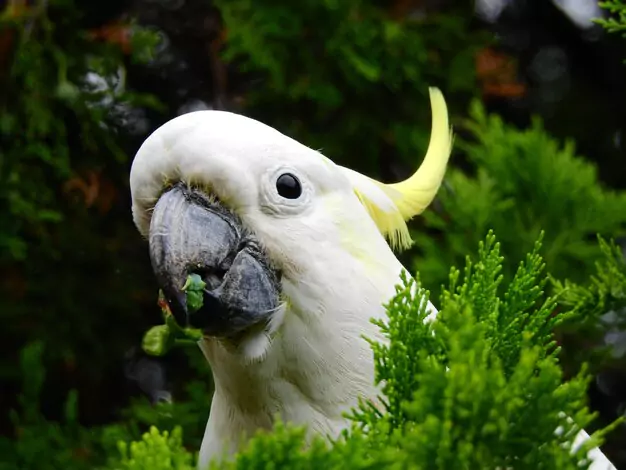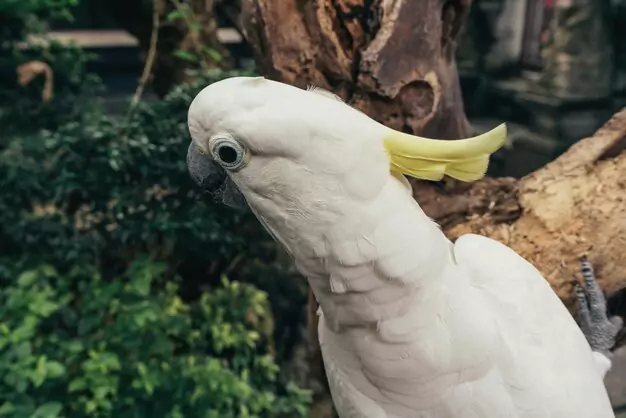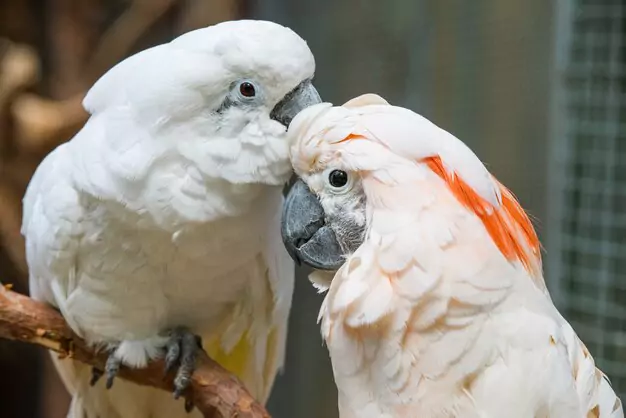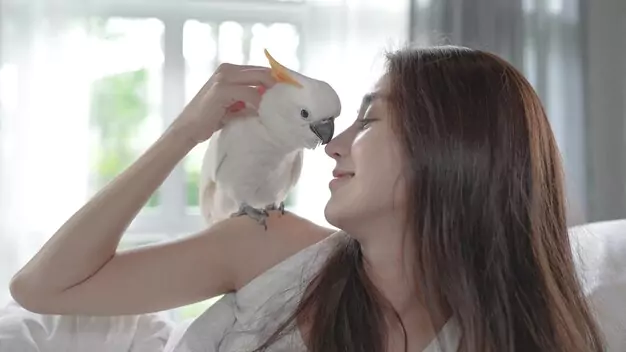Are you a proud owner of a cockatoo or considering adopting one? Understanding their behavior is crucial to their well-being and your relationship with them. Cockatoos, along with cockatiels and other parrots, are members of the Cacatuidae family, with Cacatua being the genus name for cockatoos. These highly social birds use vocalizations as a means of communication and can mimic sounds and words they hear from their surroundings, making for an entertaining companion.
Cockatoos and cockatiels, both members of the cacatuidae family, are affectionate birds that require plenty of physical and mental stimulation to stay healthy and happy. Parrots, including both species, follow a schedule of activities to help them stay organized and focused. As social creatures, the way they interact with their group members is an essential aspect of their behavior.
| Behavior | Description |
|---|---|
| Social | Cockatoos are social birds and they need plenty of interaction with their owners. They can become depressed if they are not given enough attention. |
| Playful | Cockatoos are playful birds and they love to have toys to keep them occupied. They can also be destructive if they are not given enough to do. |
| Loyal | Cockatoos are loyal birds and they can form strong bonds with their owners. They can be very affectionate and loving. |
| Noisy | Cockatoos can be noisy birds, especially when they are not getting enough attention. They can also be quite vocal at night. |
| Demanding | Cockatoos can be demanding birds and they need a lot of attention. They can also be quite stubborn. |
| Trainable | Cockatoos are intelligent birds and they can be trained to do tricks. However, they can also be difficult to train, especially if they are not properly socialized. |
| Long-lived | Cockatoos can live for a long time, up to 50 years or more. This means that they are a long-term commitment. |
| Expensive | Cockatoos can be expensive to care for. They need a large cage, a balanced diet, and plenty of toys. They also need to be taken to the vet for regular checkups. |
But where does this behavior come from? It can be traced back to their instincts and survival mechanisms. To modify cockatoo behavior, it’s important to understand these factors and provide them with a suitable environment. This applies not only to cockatoos but also to cockatiels, pink cockatoos, black cockatoos, and white cockatoos.
In this article, we’ll explore the different aspects of cockatoo behavior, including vocalizations, activity level, group interaction, schedule, and more. We’ll also answer common questions such as what is the behavior of a palm cockatoo and where to adopt or buy a cockatoo. Additionally, we’ll touch upon pink cockatoos, black cockatoos, and cockatiels, as well as pet cockatoos.
Comprehensive Knowledge About Cockatoo Behavior

If you’re considering getting a cockatoo as a pet, it is crucial to have comprehensive knowledge about their species’ behavior. Cockatoos are highly social animals that require extensive care and attention from their owners. This means that they need a lot of interaction, playtime, and mental stimulation to thrive in captivity. Understanding their sounds, size, daily needs in captivity, and more are essential for providing the best possible care for your cockatoo.
Understanding Cockatoo Care
Cockatoos, as a species, require extensive care and attention from their owners. This means they are highly social animals that crave affection and interaction with humans. Breeders should have extensive knowledge about cockatoo behavior before taking them into captivity to ensure they live a happy and healthy life.
It’s essential to provide pet cockatoos, including white cockatoos, black cockatoos, and pink cockatoos, with ample space to move around and explore. These birds are known for their playful nature and love to spend time interacting with toys or other objects in their environment.
In addition to providing your cockatoo species with adequate space, it’s also important to consider the type of food they eat. Cockatoos thrive on a diet of fresh fruits, vegetables, nuts, seeds, and pellets specifically formulated for these birds.
The Sounds of Cockatoos
One of the most unique characteristics of cockatoos, as a species, is their ability to mimic human speech and sounds. This trait makes them an incredibly popular pet choice for those seeking a companion that can provide hours of entertainment.
Cockatoos, as a species, are capable of producing a wide range of sounds beyond just mimicking human speech. They can also produce whistles, screams, squawks, hisses, growls – even musical tunes! It’s important to understand that these sounds are not always pleasant or appropriate in certain situations.
Affectionate Nature
Affection is something that cockatoos, a species of parrot, crave deeply. They form strong bonds with their human family members and will often show their love by cuddling or making soft sounds throughout the day.
Cockatoos, a species known for their loving and affectionate nature, require a lot of interaction with their owners to thrive. They can become quite demanding if they don’t receive enough attention, so it’s important to ensure you have enough time to devote to your feathered friend.
Understanding the Body Language of Cockatoos

Cockatoos are known for their unique and fascinating behavior, especially within the species. They use body language to express themselves, which includes movements, postures, and vocalizations. In this article, we will explore how to understand the body language of cockatoos.
How Cockatoos Talk
Unlike other bird species, cockatoos use their bodies to communicate. For example, when a cockatoo raises its crest, it indicates excitement or alertness. When a cockatoo flaps its wings rapidly while making noise with its beak, it might mean that the bird is happy or excited.
Furthermore, different species of cockatoos have distinct ways of communicating through body language. Black cockatoos tend to use their body language as a way of conveying aggression and dominance. On the other hand, pink cockatoos often use body language as a way of showing affection and bonding with their owners.
What Cockatoos Look Like
To understand a cockatoo’s body language fully, you need first to know what they look like. Cockatoos are medium-sized birds that come in various colors such as white, black, pink, and grey. They have large crests on top of their heads that can be raised or lowered depending on their mood.
Moreover, pink cockatoos also have bright eyes that can give you clues about how they’re feeling at any given moment. If your pink cockatoo’s eyes are wide open and staring intently at something in front of them without blinking or moving around much – they may feel threatened or anxious.
Why Cockatoos Dance
Cockatoos also dance as part of their communication process; dancing helps them bond with other birds and express joy or happiness. When your bird starts dancing around its cage or hopping from perch to perch while chirping loudly – it’s likely feeling contented and happy!
What Cockatoos Eat
Cockatoos are omnivores, which means they eat both plants and animals. They enjoy a varied diet that includes seeds, fruits, vegetables, insects, and even small animals like mice or lizards.
To keep your cockatoo healthy and happy, it’s essential to provide them with a balanced diet that meets their nutritional needs. You can also offer your bird treats such as nuts or dried fruit as an occasional reward for good behavior.
Signs of Aggression in Cockatoos
Cockatoos can be aggressive at times, especially when they feel threatened or stressed. Signs of aggression include fluffing up their feathers to look bigger, hissing or growling noises from their beaks, and biting or attacking other birds/people nearby.
If you notice any of these signs in your bird’s body language – it’s best to give them some space until they calm down. Avoid approaching them too quickly or making sudden movements that could startle them further.
Building a Strong Bond with Your Cockatoo
Understanding your cockatoo’s body language is crucial for building a strong bond with them. By learning how to interpret their movements and vocalizations correctly, you can respond appropriately and avoid misunderstandings.
For example, if your bird raises its crest while chirping happily – it might be asking for attention or affection from you. On the other hand, if it starts hissing while fluffing up its feathers – it might be feeling threatened or uncomfortable around something/someone nearby.
Common Mistakes to Avoid When Interacting with Cockatoos

Cockatoos are intelligent and social birds that can make great pets, but it’s important to understand their behavior and needs to avoid common mistakes that can lead to health problems or even aggressive behavior. Here are some tips on what not to do when interacting with your cockatoo:
Using Your Hands to Play
One of the biggest mistakes people make when playing with cockatoos is using their hands. While this may seem like a fun way to interact with your bird, it can be interpreted as aggression by the cockatoo. Cockatoos have strong beaks and can easily hurt you if they feel threatened or scared.
Instead of using your hands, try providing toys or other objects for your cockatoo to play with. This will keep them entertained while also keeping your fingers safe.
Forcing Interaction
Another mistake people make is forcing interaction with their cockatoo when the bird is showing signs of discomfort or fear. Cockatoos are sensitive creatures and need time to adjust to new situations and people.
If your cockatoo seems hesitant or scared, give them space and time to adjust. You can try offering treats or talking softly to them from a distance until they feel more comfortable around you.
Sudden Movements and Loud Noises
Cockatoos are easily startled by sudden movements or loud noises. This can cause them stress and anxiety, which can lead to health problems over time.
To avoid startling your cockatoo, move slowly and calmly around them. Try not to make sudden movements or loud noises that could scare them.
Punishing Your Cockatoo
Punishing or physically disciplining your cockatoo is never a good idea. It can lead to aggressive behavior and trust issues between you and your bird.
Instead of punishing bad behavior, try positive reinforcement techniques such as rewarding good behavior with treats or praise. This will help your cockatoo learn what behaviors are acceptable without causing them unnecessary stress or fear.
Feeding Inappropriate Foods
Feeding your cockatoo inappropriate or unhealthy foods can lead to health problems such as obesity, malnutrition, and even death. Avoid feeding your bird foods that are high in fat, salt, or sugar.
Stick to a balanced diet that includes fruits, vegetables, grains, and protein sources such as nuts or seeds. You can also consult with a veterinarian who specializes in avian care for more specific dietary recommendations.
Aggressive or Destructive Cockatoo Behavior: Scared and Aggressive

Cockatoos are affectionate birds that can turn aggressive or destructive due to fear or stress. In the wild, aggression is a natural behavior observed in cockatoos, especially among males competing for mates or territory. However, when kept in cages as pets, some cockatoos may become scared and aggressive due to various reasons.
Signs of Scared or Stressed Cockatoo Behavior
A scared or stressed cockatoo may exhibit screaming and destructive behavior. Screaming is a common way for cockatoos to communicate with their flock members in the wild. However, when kept in captivity, excessive screaming can be a sign of distress. Similarly, destructive behavior such as chewing on furniture or feathers can indicate that the bird is not getting enough attention from its owner.
Causes of Aggressive Cockatoo Behavior
Several factors can trigger aggressive behavior in cockatoos:
-
Hormonal changes: Feeding cockatoos with seeds and dust can trigger hormonal changes that may cause aggressive or destructive behavior.
-
Lack of socialization: Isolating your pet cockatoo from other birds and humans can lead to boredom and frustration.
-
Health issues: Illnesses such as infections or injuries can cause discomfort and pain, which may manifest as aggression.
-
Lack of exercise: Cockatoos need regular exercise to maintain their physical health and mental well-being. A lack of exercise can lead to restlessness and irritability.
Galahs Forming Gangs
Galahs are known to form gangs in the wild, which can lead to aggressive behavior when kept in captivity with other birds. It is important to ensure that your pet galah has enough space and resources (food, water, toys) so it does not feel threatened by other birds.
Dealing with Aggressive Cockatoo Behavior
If you notice signs of aggressive or destructive behavior in your pet cockatoo, it is important to address the issue promptly. Here are some tips:
-
Consult with a veterinarian to rule out any underlying health issues that may be causing the behavior.
-
Increase socialization and playtime with your bird to reduce boredom and frustration.
-
Provide plenty of toys and chewable items to keep your bird occupied.
-
Train your bird using positive reinforcement techniques such as clicker training or target training.
-
Avoid punishing or yelling at your bird, as this can increase its stress levels.
Health-related Cockatoo Behavior: Common Problems

Cockatoos are beloved pets known for their playful and affectionate personalities. However, like any other pet, they can experience health problems that affect their behavior. In this article, we will discuss some common health-related cockatoo behavior problems.
Feather Plucking
Feather plucking is a common problem in cockatoos that can be caused by stress or medical issues. This behavior involves the bird pulling out its feathers with its beak, which can lead to bald patches and skin irritation. If you notice your cockatoo feather plucking excessively, it’s important to take them to a veterinarian to rule out any underlying medical conditions.
Beak Overgrowth
Beak overgrowth is another common problem in cockatoos that can affect their eating and grooming habits. Cockatoos’ beaks grow continuously throughout their lives, so regular trimming may be necessary to prevent overgrowth. If left unchecked, overgrown beaks can cause difficulty eating and grooming, leading to further health problems.
Respiratory Infections
Respiratory infections are a significant health concern for cockatoos and can lead to symptoms such as coughing, sneezing, and difficulty breathing. These infections are often caused by bacteria or viruses and can spread quickly among birds. If you suspect your cockatoo has a respiratory infection, it’s crucial to seek veterinary care immediately.
Psittacine Beak and Feather Disease (PBFD)
Psittacine Beak and Feather Disease (PBFD) is a viral infection that affects the feathers, beak, and immune system of cockatoos. PBFD is highly contagious among birds and can have devastating effects on affected individuals. Symptoms of PBFD include feather loss or abnormal growth patterns, deformities in the beak or claws, weight loss, lethargy, diarrhea, or vomiting. There is no cure for PBFD, and infected birds often have to be euthanized to prevent the spread of the virus.
Malnutrition
Malnutrition is a serious problem in cockatoos that can lead to a range of health issues, including weakened immune systems and poor feather quality. Cockatoos require a balanced diet that includes fruits, vegetables, nuts, and seeds. A diet lacking in essential nutrients can lead to serious health problems over time. Make sure your cockatoo has access to fresh food and water at all times.
Cockatoos as Pets: Comparison with Other Bird Species, Further Research

Cockatoos are one of the most popular bird species kept as pets due to their playful and affectionate nature. However, they require a lot of attention and care compared to other bird species like cockatiels. In this section, we will compare cockatoos with other bird species and discuss the need for further research on their behavior in captivity.
Cockatoo vs. Cockatiel: Personality Differences
Cockatiels are smaller than white cockatoos and have a quieter personality, making them more suitable for apartment living. White cockatoos have a louder and more demanding personality that requires more time and attention from their owners. They also tend to be more destructive when they are bored or not stimulated enough.
The Cacatuidae Family
Cockatoos belong to the family Cacatuidae, which includes 21 species of birds known for their distinctive crests and curved bills. These birds are native to Australia, Indonesia, Papua New Guinea, and some Pacific islands.
Intelligence and Social Behavior
Like other parrots, cockatoos are intelligent and social animals that can form strong bonds with humans. They require regular interaction with their owners to maintain their mental health and well-being. Cockatoos can learn tricks, mimic human speech, and even solve puzzles.
Diet and Nutrition
A balanced diet is essential for pet cockatoos’ health, which should include a variety of fresh fruits, vegetables, nuts, and seed pellets specifically formulated for parrots. A diet consisting only of seeds is inadequate because it lacks essential nutrients like vitamins A and D3.
Further Research Needed
While much is known about the behavior of wild cockatoos in their natural habitat, there is still much we don’t know about how different cockatoo species behave in captivity. More research is needed to better understand their preferences for toys, homes, and interaction times with humans. This research can help us provide better care for pet cockatoos and improve their overall well-being.
Understanding Cockatoo Emotions: Excited, Happy, Unhappy, Sick

Cockatoos are social and intelligent birds that can express a wide range of emotions. As a cockatoo owner, it is important to understand your bird’s emotions and behaviors to provide appropriate care and address any potential health concerns. In this article, we will discuss the different emotions that cockatoos may exhibit – excitement, happiness, unhappiness, and sickness – and how to recognize them.
Excitement
Excitement is a common emotion expressed by cockatoos. They may become excited when they see their favorite food or toy or when they are about to interact with their owners. Vocalizations and body language are common ways for cockatoos to express excitement. They may flap their wings rapidly or hop up and down while making loud noises.
If your cockatoo is excited, you may notice some of the following behaviors:
- Rapid wing flapping
- Hopping up and down
- Loud vocalizations
- Preening behavior
- Dilated pupils
It is important to note that excessive excitement can lead to stress in cockatoos. If you notice your bird becoming overly excited or agitated frequently, it may be helpful to provide more enrichment activities or toys.
Happiness
Happy cockatoos display relaxed body language and enjoy social interaction with their owners. They may lower their crest feathers and hold them against their head as a sign of contentment. Cockatoos also enjoy being petted on the head or neck by their owners.
If your cockatoo is happy, you may notice some of the following behaviors:
- Relaxed body posture
- Lowered crest feathers
- Purring sounds
- Enjoyment of social interaction with humans
Providing regular playtime with your bird can help promote happiness in your pet.
Unhappiness
Unhappy cockatoos may exhibit aggressive behavior, such as biting or screaming. They may also withdraw from social interaction and become more solitary. Cockatoos can become unhappy for various reasons, including boredom, lack of attention, or illness.
If your cockatoo is unhappy, you may notice some of the following behaviors:
- Aggressive behavior (biting or screaming)
- Withdrawal from social interaction
- Feather plucking
- Loss of appetite
It is important to address any potential causes of unhappiness in your cockatoo promptly. Providing appropriate enrichment activities and spending quality time with your bird can help alleviate this negative emotion.
Sickness
Sick cockatoos may show signs of lethargy, loss of appetite, and changes in their vocalizations or behavior. It is essential to monitor your bird’s health regularly and seek veterinary care if you notice any concerning symptoms.
If your cockatoo is sick, you may notice some of the following symptoms:
- Lethargy
- Loss of appetite
- Changes in vocalizations or behavior
- Respiratory distress (labored breathing)
Regular veterinary check-ups can help identify any physical or emotional issues that may be affecting a cockatoo’s well-being.
Beak Fencing and Jousting in Cockatoo Behavior: Focus on Beaks and Head

If you own a cockatoo, you may have observed them engaging in beak fencing or jousting. These are common behaviors that these birds display when they spar with each other. In this section, we will discuss the different aspects of beak fencing and jousting in cockatoo behavior, focusing on their beaks and heads.
What is Beak Fencing and Jousting?
Beak fencing is a behavior where two cockatoos face each other and use their beaks to spar. They move their heads back and forth while clicking their beaks together. This behavior can sometimes escalate into jousting, where the birds lunge at each other with their beaks open.
Cockatoos also use their heads during these interactions by fluffing up their feathers and lowering their head to intimidate their opponent. They may also raise one wing while keeping the other down as a form of balance during the interaction.
Why Do Cockatoos Engage in Beak Fencing and Jousting?
Beak fencing and jousting are natural behaviors for cockatoos that help them establish dominance hierarchies within flocks. These behaviors can also be seen during playtime or when competing for attention or treats from their owners.
some cockatoos may engage in beak fencing or jousting to establish who gets access to food first. If multiple birds are living together, they may engage in these behaviors to determine who gets priority access to perches or toys.
Encouraging Natural Behaviors
As a responsible owner, it is essential to provide your cockatoo with an environment that encourages natural behaviors such as beak fencing and jousting. One way to do this is by providing your bird with branches and vegetables to chew on. This will help satisfy their need to chew and provide them with mental stimulation.
It is also important to ensure that your cockatoo has enough space to spread its wings and flip them during play. Cockatoos require a minimum of 18 inches of space between perches to allow for wing flipping, which is an essential part of their natural behavior.
Signs of Aggression
While beak fencing and jousting are natural behaviors for cockatoos, it is crucial to monitor these interactions closely. Sometimes, what may seem like playful behavior can escalate into aggression quickly.
Signs of aggression in cockatoos include eye pinning, fluffed-up feathers, raised crest, tail fanning, and lunging. If you notice any of these signs during beak fencing or jousting interactions, it’s best to separate the birds immediately.
Key Takeaways on Cockatoo Behavior
Now that you have comprehensive knowledge about cockatoo behavior, it’s essential to understand their body language. Knowing how to read their movements and gestures can help you avoid common mistakes when interacting with them.
However, even with the best intentions, aggressive or destructive behavior in cockatoos can still occur. In such cases, it’s important to recognize that they may be scared or feeling threatened.
Health-related issues can also affect a cockatoo’s behavior. Common problems include feather plucking and respiratory infections.
While cockatoos can make great pets, it’s worth comparing them with other bird species before making a decision. Further research can help you decide if they are the right fit for you.
Understanding a cockatoo’s emotions is crucial for their well-being. They can experience excitement, happiness, unhappiness, and sickness – all of which require different responses from their owners.
Beak fencing and jousting are unique behaviors in cockatoos that focus on their beaks and heads. It’s important to monitor these behaviors closely to ensure they don’t lead to injury or aggression towards other birds.
In conclusion, knowing how to interpret a cockatoo’s behavior is key to building a healthy relationship with them. By avoiding common mistakes and recognizing warning signs of aggression or illness, you can provide the best care possible for your feathered friend.








